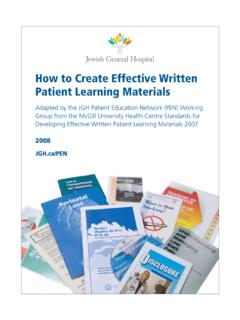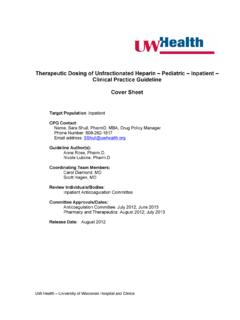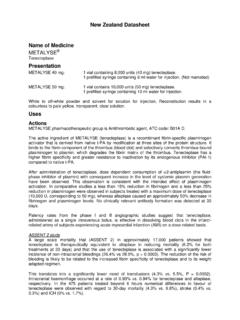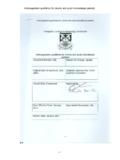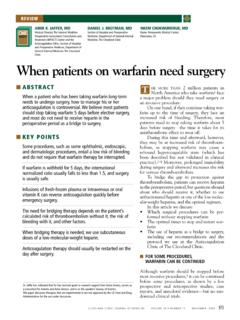Transcription of PRACTICE GUIDELINES FOR ANTICOAGULATION …
1 PRACTICE GUIDELINES FOR ANTICOAGULATION MANAGEMENT 3RD EDITIONFrom the Division of Hematology and Pharmacy with contributions from the Division of Cardiology, the Thrombosis Research Group, Department of Dentistry and Department of Neurology These GUIDELINES are based on the 2012 ACCP GUIDELINES for antithrombotic therapy and incorporate the usual PRACTICE at the Jewish General : Mark Blostein, MD Ryan Kerzner, June 2012A French version is available upon request. Une version fran aise est disponible sur the Division of Hematology with contributions from the Division of Cardiology, the Thrombosis Research Group, Department of Dentistry and Department of NeurologyThese GUIDELINES are based on the 2008 ACCP GUIDELINES for antithrombotic therapy and incorporate the usual PRACTICE of the ANTICOAGULATION clinic at the SMBD-Jewish General Overview of Anticoagulant Medications ..32. Reversal Agents ..93. Conversion from One Anticoagulant to Another.
2 124. Atrial Fibrillation ..135. Venous Thrombosis (DVT/PE) ..186. Heart Valves ..257. Bridging Therapy ..268. Use of Combined Coronary Artery Disease/ Heart Failure ..3110. Cerebrovascular (CVA) Disease ..3211. heparin -Induced Thrombocytopenia (HIT) ..332 IntroductionThese GUIDELINES were developed to serve as a tool for physicians and other healthcare professionals to help with the management of ANTICOAGULATION . They should in no way be used to replace clinical judgment. We are not responsible for any adverse medical outcomes as such responsibility lies with the treating physician. The Hematology or Thrombosis consult services can al-ways be consulted for specific patients with more complex needs. Pharmacy can be consulted as well for help with dosing and monitoring of anticoagulant medications. AbreviationsACS Acute Coronary SyndromeAF Atrial FibrillationaPTT activated Partial Thromboplastin TimeCHF Congestive Heart FailureCrCl Creatinine ClearanceDVT Deep Vein ThrombosisFFP Fresh Frozen PlasmaHIT heparin -Induced ThrombocytopeniaINR International Normalized RatioLMWH Low Molecular Weight HeparinMI Myocardial InfarctionPE Pulmonary EmbolismpRBC packed red blood cellsTIA Transient Ischemic AttackUFH unfractionated HeparinVTE Venous of Anticoagulant MedicationsA.
3 unfractionated heparin . Inhibits thrombin by accelerating the activity of Dose of heparin . Treatment: 80 units/kg IV bolus (if desired) then 18 units/kg/hr IV infusion. Check aPTT 6 hours after bolus and adjust infusion to maintain aPTT within the therapeutic range established by the local laboratory. It is recommended to use an algorithm-based dosing protocol Consult Thrombosis if weight > 120 kg. Prophylaxis: 5000 units sc q12hr (or q8hr if obese weight >120 kg).. There are no dose adjustments required for renal failureB. Low Molecular Weight HeparinEnoxaparin (Lovenox )Dalteparin (Fragmin ) Tinzaparin (Innohep ). Directly inhibits factor Xa activity. Dose of enoxaparin. Treatment: mg/kg sc qday or 1 mg/kg sc BID (the latter regimen is preferred in ACS and obesity) Renal failure (CrCl 15-30 mL/min): 1 mg/kg sc qday. Prophylaxis: 40 mg sc qday (except post-op hip/knee surgeries: 30 mg sc BID) Renal failure (CrCl 15-30 mL/min): 30 mg sc Dose of dalteparin.
4 Treatment: 200 units/kg sc qday Renal failure (CrCl 15-30 mL/min) : Consider Anti-Xa levels for dose adjustments. Prophylaxis: 5000 units sc qday. Dose of tinzaparin. Treatment: 175 units/kg sc qday. Prophylaxis: 3500 units/kg sc qday. Consult Thrombosis if weight > 120 kg for all forms of LMWH. Monitoring. Routine monitoring is not required for LMWHs. Anti Xa levels, which must be approved by Thrombosis or Hematology, may be useful in the following situations: Renal failure Extreme weights Pregnancy Recurrent thromboses on therapeutic dosesC. Warfarin (Coumadin ). Inhibits the proper synthesis of the vitamin K-dependent clotting Initiate warfarin at 5-10 mg po qday. Consider lower doses in the elderly, patients with impaired nutrition, liver failure, congestive heart failure, or with a high risk of bleeding.. No dose adjustment is required in renal An initial INR should be done on Day 3. In the absence of any bleeding, the warfarin dose should be adjusted based on the table below.
5 An INR should then be done every 3-4 days, until the INR is therapeutic and The INR should be checked within 1-2 weeks of any change in Any INR that falls below the therapeutic range should be checked within 1-2 weeks whether or not the dose is INRs should be checked every 8 weeks (6 weeks for mechanical valves) and only if INR values are For very stable patients within the therapeutic range for the previous 6 months, INRs may be checked every 12 weeks (does not apply to patients with mechanical valves)INRDose Adjustment< weekly dose by 10-20%, consider dose by 10-20% one dose then restart with a lower dose (10-20%) two doses and remeasure INR in 48 hours> Warfarin and Administer Vitamin K, Remeasure INR in 48 hours6D. Rivaroxaban (Xarelto ). Inhibits Factor Xa. Indicated for the prevention of VTE in patients who have undergone elective total hip replacement or total knee replacement surgery, for the prevention of stroke and systemic embolism in patients with atrial fibrillation, and for the treatment of DVT without symptomatic pulmonary Dose.
6 For orthopaedic prophylaxis: 10 mg po qday (14 days for knee replacement/ 35 days for hip replacement). For Atrial Fibrillation: 20 mg po qday or 15 mg po qday if CrCl 30-49 mL/min. For treatment of DVT: 15 mg po BID for 3 weeks, followed by 20 mg po qday or followed by 15 mg po qday if CrCl 30-49 mL/min. Contraindicated in severe renal failure (CrCl < 30 mL/min). No ANTICOAGULATION monitoring required E. Dabigatran (Pradax ) . Direct thrombin inhibitor. Indicated for the prevention of stroke and systemic embolism in patients with atrial fibrillation and for the prevention of VTE in patients who have undergone elective total hip replacement or total knee replacement Dose in atrial fibrillation:. 150 mg po BID or. 110 mg po BID if age > 75 or in patients with increased risk of bleeding7. Dose in hip/knee replacement surgery. 220 mg po qday or. 150 mg po qday if age > 75. Contraindicated in severe renal failure (CrCl < 30 mL/min), caution for patients with moderate renal impairment (CrCl 30-50 mL/min).
7 Monitoring . Normally, no ANTICOAGULATION monitoring required . PTT: INSENSITIVE: If abnormal then there is significant drug present. However, a normal PTT does not necessarily mean there is no effect of dabigran.. Thrombin Time (TT): TOO SENSITIVE but a normal TT assures that there is no remaining anticoagulant effect of dabigatran. An abnormal thrombin time from dabigatran does not imply that hemostasis is Fondaparinux (Arixtra ). Inhibits Factor Xa. Dose for VTE prophylaxis. mg sc qday. Dose for VTE treatment and for suspected HIT. 5 mg sc qday if weight < 50 kg. mg sc qday if weight 50-100 kg. 10 mg sc qday if weight > 100 kg. Dose for Unstable Angina/NSTEMI. mg sc qday8. Dose for STEMI (in patients who are managed with thrombolytics or who initially are to receive no form of reperfusion therapy). mg IV x 1, then mg sc qday. Not recommended in severe renal failure (CrCl < 30 mL/min). No monitoring requiredG.
8 Argatroban . Direct thrombin inhibitor. Indicated in patients with heparin -induced thrombocytopenia who require Dose and monitoring. Initial: 2 mcg/kg/min continuous IV infusion ( mcg/kg/min if moderate hepatic impairment).. Send aPTT 2 hours after initiation of therapy. Adjust dose to reach target aPTT of to 3X baseline. Infusion rate should not exceed 10 mcg/kg/min. Argatroban prolongs the INR, thus complicating the monitoring of No dose adjustments required in renal AgentsA. Protamine. Dose for heparin reversal (max. dose 50 mg):. unfractionated heparin : 1 mg IV per 100 units (if administered within previous 30 minutes) mg IV per 100 units (if 30-60 minutes have elapsed since heparin administration) mg IV per 100 units (if more than 2 hours have elapsed since heparin administration) . Enoxaparin: 1 mg IV per 1 mg (only 50% effective). Dalteparin: 1 mg IV per 100 units (only 75% effective). Tinzaparin: 1 mg IV per 100 units (only 80% effective).
9 Protamine should be administered over at least 10 minutes to avoid severe hypotension and patients must be monitored for anaphylactoid Vitamin K/Octaplex/Fresh Frozen Plasma. The following table summarizes the management of anticoagulated patients on warfarin with either elevated INRs, bleeding, or in need for urgent reversal for surgical/medical procedures:* Octaplex candidate: patient on warfarin or vitamin K deficient requiring urgent normalization of their INR for active bleeding or urgent surgery (< 6 hours)** Contraindication to Octaplex: history of HIT, allergy to product, high risk of thrombosis (recent MI, PE, DVT, CVA)BleedingINRA ctionNo< Decrease warfarin dose by 10-20% Hold warfarin until INR therapeuticm Restart at lower doseNo> 10m Hold warfarin until INR therapeuticm Vitamin K mg PO x 1m Restart at lower doseNo> 2 and urgent procedure neededm Hold Warfarinm Octaplex candidate*: Vitamin K 10 mg IV over 30 min Octaplex as per Blood Bank protocol INR corrects within 1 hourm Not Octaplex candidate**.
10 Vitamin K 5-10 mg IV over 30 min FFP 15 mL/kg INR corrects within 8 hoursYe s> 211 Dosing of Octaplex:. 1000 U if INR < 2000 U if INR 3000 U if INR > Vitamin K particularities:. High doses of vitamin K may lower INR more than is necessary and may lead to warfarin resistance for up to one Oral vitamin K is the treatment of choice due to its predictable efficacy and to its safety and convenience . IV vitamin K may be associated with anaphylaxis. It should be reserved for more urgent situations to reverse Response to SC vitamin K may be unpredictable and sometimes delayed Dabigatran/Rivaroxaban. No available reversing agent. Supportive care with pRBCs and FFP while drug wears off (depending on half life and creatinine clearance). Dialysis suggested for dabigatran but efficacy unproven. HEMATOLOGY OR THROMBOSIS CONSULT SUGGESTED12 CrClFROM Dabigatran/ RivaroxabanTO Dabigatran/ RivaroxabanUnfrac-tionated heparin30-50 mL/min24 hours after last dosestart immediately after discontinuing IV heparin >50 mL/min12 hours after last dosestart immediately after discontinuing IV heparinLow Molecular Weight heparin 30-50 mL/min12-24 hours after last dosestart 6 hours after last dose>50 mL/min6-12 hours after last dosestart 6 hours after last doseWarfarin 30-50 mL/min4 days before discontinu-ing.
